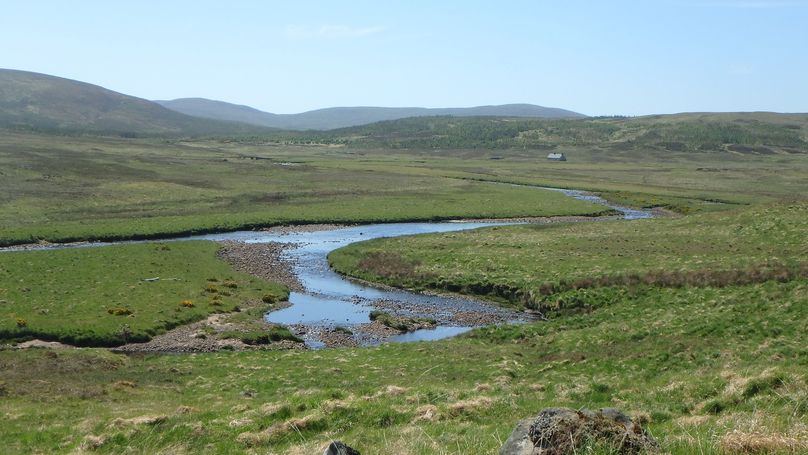When the proprietors of the Brora District salmon fishery Board in sutherland decided to try to build climate change resilience into the river system, they commissioned a root-andbranch survey of the river and its habitat.
The Brora is a good salmon and trout river, and the survey, carried out in 2018 by Dr Jon Watt and Isabel Isherwood of Waterside ecology, mainly concentrated on salmon, but the results have been very interesting.
Arctic charr were also found to be present and these are likely to be the first fish to have colonised the river after the last ice age.
The survey showed the river system to be in a healthy state with good areas of spawning and juvenile habitat. There are about 108,000 sq m offry habitat and 753,000 sq m of mixed juvenilehabitat.
Healthy populations of salmon in the three main tributaries of the Brora have been shown in electrofishing surveys, which have increased since 2018, partly because of the scottish Government’s National electrofishing Programmewhich each district undertakes on behalf of Marine scotland science, but also as a health check on the river and to inform management practices.
Having found the population of juvenile fish and the in-river habitat to be in relatively good order, the board looked at the wider landscape to see what improvements could be made to create resilience for the future. river and habitat management needs to be considered holistically as actions in the water catchment can have an impact within the river – whether that be the detrimental effect of pollution or the positive impact of native woodland.
One of the major challenges for the River Brora is the water temperature in summer. Marine scotland science has been recording water temperatures in the Brora for a number of years. The upper reaches of the catchment have no trees and water temperatures have been recorded as some of the warmest in scotland.
High water temperatures can stress fish and make them more vulnerable to disease, predation and other environmental fluctuations. Temperatures above 23°C can be lethal.
Work on North American salmon has shown that ideal temperatures are between 13°C and 18°C, while winter temperatures above 11°C can cause genetic abnormalities and mortality in salmonid eggs. Higher winter temperatures can also cause eggs to hatch too early making alevins more vulnerable to winter spates.
Marine Scotland science modelling shows water temperatures of 24°C are likely in the Brora headwaters in hot summers. To try to combat the increasing water temperature, the board has been looking at native riparian tree planting to provide dappled shade on the water.
Planting trees on the south bank of a river flowing west to east creates the best shade. unfortunately, planting trees on a river flowing from north or south will not have the same impact because of the angle of the sun. The effect is greatest in shallow and slow-flowing areas. Habitat surveys found extensive reaches of shallow habitat in the headwaters of all three tributaries of the Brora, as well as long reaches of slow-flowing water in the upper Brora. This data will allow the board to identify areas that will provide the most benefit from planting. However, any proposals will need to take account of other interests, such as deer, farming and groundnesting waders, plus factors such as soil suitability. The overall strategy of improvement and tree planting requires consultation and analysis with various stakeholders.
Further considerations are peatland restoration, which scottish Natural Heritage is keen to promote through its Peatland Action programme, which has seen more than 19,000 hectares of peatland improved. Previous estate management practices would involve draining large areas of hill, and this was also the case for older hydro schemes. reducing the number of drains can reduce the run-off speed and create resilience in the river. This will have the effect that rivers rise and fall more slowly. The potential benefits include reducing erosion (habitat damage and also potential risk to eggs, alevins and fry), reducing the length and severity of periods of very low water during dry spells, and reducing downstream flood-risk to property, farmland andlivestock.
Peatland restoration grants will allow these old drains to be blocked. eroded peat hags, which can introduce fine sediment to the river, are alsoof concern in the upper catchment and they can cause issues with spawning grounds. It is possible to re-grade these and introduce mattedvegetation from healthy parts of the moor, although this is not particularly severe on the Brora.
With larger scale catchment surveys it is possible to effect greater change quickly with more tree planting and peatland restoration. It is not a quick fix – it will take the trees 20 years to provide sufficient shade – but hopefully it will eventually increase the survival of juvenile fish so that they can migrate as smolts. The lower water temperatures will also help the returning adult fish by reducing stress and fungal infection.
Landowners can make small changes that affect the river, whether it is reducing fine sediment introduction to the river (reducing livestock poaching), riparian tree planting or barrier removal. such improvements do not need to be done on a catchment-wide basis, but if each owner does a little it can start to create more resilience for the river and the juvenile fish.
With the sea survival of salmon down to between 3% and 5%, ensuring that the river is healthy and able to produce enough juveniles willin turn ensure there are sufficient returningsalmon and sea trout to re-stock these river systems.
